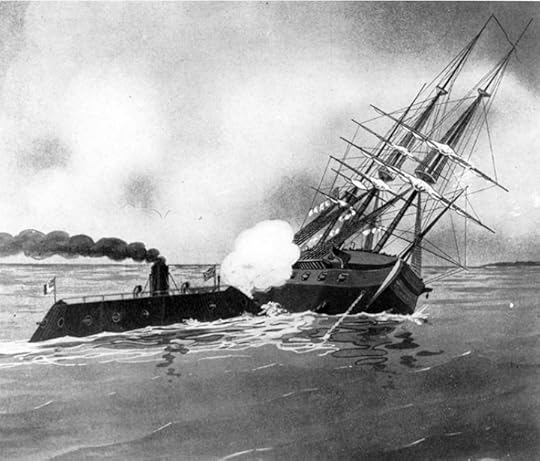Thomas E. Ricks's Blog, page 60
February 26, 2014
Thanks, NSA! I guess the U.S. economy didn't need that $22 billion in business

The latest estimate I've seen
of the cost of the
NSA surveillance program in terms of lost business to U.S.
companies is at least $22 billion. "The economic consequences of national
security decisions should be part of the debate, and this cannot happen until
more details about PRISM have been revealed," the study notes.
This is what happens when secret
policemen make far-reaching decisions in secret and then say the justifications
for their acts must remain secret. And yes, I blame Congress too.
Desch and Ricks are too optimistic about the effects of budget cuts on the military

By Lindsay P. Cohn
Best Defense guest
respondent
Michael Desch
makes a number of good points in his recent CNN
opinion piece arguing that "Cutting the Army will Make it Stronger." His
main point is that cutting the military's size and budget is both necessary and
good. In many ways, I agree with his broad claim. I have to point out, however,
that cutting alone does not magically produce either efficiency or innovation. How we cut is just as important ... and
the bad news is that how we are cutting is not ideal.
Desch argues that "bold budget cuts constitute opportunities
to subject old and obsolete ways of doing business to ... 'creative destruction'."
This is similar to an argument Tom Ricks made in December in the Washington Post, titled "To
Improve the US Military, Shrink It." Michael Horowitz wrote an
excellent response which points out that, "for smaller to lead to 'smarter,'
the Department of Defense will have to respond to budgetary pressure by
allocating more resources to innovative experimentation." As Horowitz notes,
the Pentagon is unlikely to do this: "new technologies and operational
concepts, lacking built-in constituencies and powerful institutional support,
can often end up as the first on the chopping block, rather than as a focal
point for the future." Desch and Ricks are right that a period of shrinking and
budget cutting presents an opportunity to engage in re-imagining the military
organization, but opportunities do not execute themselves.
Horowitz has made a compelling case that cuts do not lead
automatically to innovation; I am making the case that cuts do not lead
automatically to efficiency. Desch rightly points out that personnel costs are
a significant chunk of military spending, and will need to undergo significant
cuts. Todd
Harrison of the Center for Strategic and Budgetary Assessments (CSBA) has
noted, with respect to the growing costs per servicemember, that "if we
continued allowing our personnel costs to grow at [the same rate as the past
decade], by the year 2039, those personnel costs would consume the entire
defense budget." All analysts agree that costs per servicemember are too high
and growing too fast to be sustainable. A few attempts at containing these
costs have already been made, as in the Ryan-Murray budget measure to cut by 1
percent the rate at which military cost of living adjustments grew for retirees
under 62, or the discussion about reducing commissary benefits. Both of these
energized vocal protest from the military and veteran communities, and both of
them have been essentially killed in Congress. Politically speaking, it is
currently impossible to cut personnel costs in any way other than cutting
personnel.
Cutting personnel is actually appropriate, as Desch points
out. Unfortunately, the reality of congressional politics and of the budgeting
enforced by the Budget Control Act/sequestration is that the Pentagon will have
to cut what it's possible to cut, not what it makes most sense to cut.
It is a mistake to believe that reducing numbers
automatically introduces efficiency. In a normal American firm, cutting
personnel is an efficient means of reducing costs because a firm can choose
whom it wants to fire and can engage in lateral hiring when its need for
personnel increases again. In the military, however, one cannot simply fire the
lowest-performing people and replace them with new hires, nor can one engage in
lateral hiring for certain specialties when a sudden need arises (e.g. combat
medics, artillerymen, military lawyers). While it is possible to pass over
low-performing officers and deny re-enlistment requests from below-average
enlisted personnel, the military has little control over the timing of such
actions, and may face budgetary time limits that force out higher performers. In
general, the forces will achieve personnel cuts by reducing recruiting and
relying on voluntary attrition. This is an inefficient means of managing
personnel. Significant cuts to recruiting will create a sort of demographic
trough on the heels of the Iraq-Afghanistan bulge, and relying on voluntary
attrition is likely to drive the best people out of the force as they realize
that they have attractive options outside the military.
For these reasons, it is vital to shape the force rather
than simply cutting it. The Army Reserve and National Guard forces should be
re-structured to ensure that they maintain adequate numbers of those
occupational specialties that cannot be hired quickly on contract. Bonuses
should be carefully targeted. The Budget Control Act should be revised to
provide the services more flexibility in how much they cut from which parts of
their budgets. As it stands, they are being forced to cut both high and
low-performing programs and people, which is the opposite of what Ricks and Desch
hope would happen under the pressure of a budget squeeze.
Give the services more flexibility and they will have both
the opportunity and the incentive to cut what doesn't work and focus on what
does.
Lindsay P. Cohn
is an assistant professor of
political science at the University of Northern Iowa. She is spending the
2013-14 year as a Council on Foreign Relations international affairs fellow,
working for the deputy assistant secretary of defense for special operations
and combatting terrorism. The opinions expressed here are her own and do not
reflect those of the U.S. government or Department of Defense.
February 25, 2014
FoW essay (9): There won't be a next war, because the current one will never end

By Christopher Davis
Best Defense future of war entry
At
the start of the War on Terrorism, senior officials in the Bush administration
argued that America was entering an era of persistent conflict. This perpetual
war would span generations due to the difficulty and expense of driving out
virulent ideologies, particularly violent Islamism, throughout the world.
Although the United States has entered an era of persistent conflict, it is not
because of radical ideologies rebelling against America's global presence. It
is because of the emergence of autonomous fighting machines (AFMs) at the
disposal of narrow executive bureaucracies. There will not be a "next" war
because America has already entered its last war -- a war unending.
The
Unending War has several causes. First, the War on Terrorism has spurred the
wide use of semi-autonomous fighting machines. The first generation of these
machines was restricted mostly to surveillance. The GWoT witnessed the
introduction of armed aerial drones and counter-IED robots. Now, the military openly
discusses fielding large numbers of machines to serve nearly every war-fighting
function, including killing the enemy face to face. AFMs are a political
godsend to executive branch officials because they do not put soldiers' lives
at risk (thereby eliminating the political dilemma of domestic backlash caused
by casualties in foreign expeditions) and they offer plausible deniability
abroad and at home alike. Machines do not complain about the lack of available
armor or defect to Canada over the moral justification of war. They fight and
die as ordered.
Second,
machines radically alter the sustainment chain. They do not need food or water,
nor need specialized equipment to operate in dangerous environments. An army of
technicians, engineers, and operators maintain and control their every move
(or, perhaps in the near future, monitor their autonomous actions within a
defined boundary of orders) from a safe distance. They can be replaced or
modified as necessary without opposition from veterans' organizations or
Congress. And their control by specialized technicians in well-developed
bureaucracies insulates their use from external oversight or intervention.
Theoretically, an entire war could be waged without a single risk to an American
life and, more frighteningly, without any knowledge at home about it.
Already,
the United States has exploited these advantages to wage a war without apparent
end from the sky against Islamic militants around the globe. No clear end-state
can be discerned from the campaign, nor is there any official measurement of
the war's progress except abstract statements about successful strikes.
International borders are freely ignored and secret agreements are made with
"host" governments to minimize their obstruction. These seismic changes were
felt with the first generation of
drones and robots. What will future generations bring?
The
introduction of these weapons on a wider scale is forthcoming. Air Force
enthusiasts speaking about the sixth generation of fighter aircraft speculate
that it will be pilotless. Special Operations Command is pushing aggressively
for new technologies to radically improve the capabilities of its operators.
Combined with the insulation of the military from the general public, the
relatively free hand of the president in directing foreign policy, the
increasing costs of maintaining an all-volunteer military in an age of
austerity, and the proliferation of threats in a globalizing multipolar world,
AFMs offer the only way forward to answer the national security problems of the
future.
Instead
of thinking about strategy, we should be thinking about the continuation of the
American way of war. This can be addressed through examining the legal and
ethical implications of armies constituted in large part by autonomous fighting
machines. Does shooting down a drone constitute an act of war? What about
crashing it into the ground through a cyberattack? If a semi- or fully
autonomous war machine commits a war crime, who is at fault? If the defined
operating parameters of an AFM could lead to a war crime, is it a lawful order
to program the AFM with those parameters? These questions and more touch the
fundamental human component of warfare -- a feature that is increasingly
distant from the battlefield.
America has already entered its last war. This war, the war unending, will be
fought with ever advancing machines of all kinds. These machines will be
increasingly autonomous and they will take commands from insulated
bureaucracies with limited public oversight. Policymakers will be less timid
about their employment. The foundations for this war have already been set in
places like Pakistan, Somalia, and Yemen. As the last Islamist terrorist draws
his final breath, against whom will these machines be pointed next?
Christopher
Davis is an Army civilian and Army Reserve officer, having previously served on
active duty for several years, including a year in RC-East, Afghanistan. He
also is a full-time doctoral student at Nova Southeastern University, studying
international peace and conflict. This
article represents his personal opinion and is not necessarily that of anyone for
whom he works.
Most misleading news story of the day: The NY Times's screwed-up comparison

Unfortunately
the Dewey Award for screwing up the news goes to the New York Times for a story yesterday that stated that the U.S. Army would be cut to its pre-World
War II size.
This was technically, narrowly correct and yet, at the same time, quite
misleading. In fact, it is a mess, and not just on timing, because it leaves
out the Air Force.
Yes, if
Defense Secretary Hagel's proposed cuts go through, the Army will be trimmed to
its 1940 size of about 450,000, and at that point the United States had not
entered World War II. But it was rapidly getting ready for it, and had been
since George Marshall had taken over leadership of the Army in 1939, when the
Army, including the Army Air Force,
was at under 200,000. That is the real pre-World War II number.
So, in
fact, if the proposed Hagel cuts go through, the contemporary U.S. Army and the
U.S. Air Force, combined, will be close to 800,000
-- that is, roughly four times the
size of their pre-war counterpart. Hence the Dewey Award.
Here's a good summary of what the SecDef actually had
to say.
The organizer of America First was, years later, Reagan's ambassador to Norway

I was reading a
history of the years leading up to U.S. involvement in World War II and out of curiosity
looked up Robert D. Stuart Jr., the founder of
America First, the isolationist organization today often remembered for its
association with Charles Lindbergh. I was surprised to see that, 44 years
later, Stuart became President Reagan's ambassador to Norway. More evidence
that F. Scott Fitzgerald was wrong in asserting that there are no second acts in American lives.
On the other hand, this was more like a fourth act in Stuart's long life.
February 24, 2014
The non-military nature of today's news: Big change from how we've lived for years

Ukraine. Thailand.
Venezuela.
None of those civil
disturbances are situations that might remotely engage the U.S. military, even
if Putin gets all fraternal with his assistance to Ukraine. And Syria, while a
war, isn't something I think the U.S. military needs to worry much about
getting involved in. Even Somalia, Yemen, North Korea, and Pakistan, the four
horsemen of dependable messes, seem to be going through relatively quiet
periods. Egypt, I dunno, but it also seems to be taking a timeout.
So, for the first
time in about 13 years, I wake up each morning without expecting the overnight
news to provide me something new to think about in terms of U.S. military
action. This feels a bit weird to me -- but also good.
On the other hand,
no one is paying much attention to Cuba, but I wouldn't be surprised to see a
massive humanitarian problem there after the Castro regime falls, one that
might well require South American troops helping distribute American-provided
aid.
Meantime, enjoy the
extra 15 minutes of sleep.
Is high tech making it easier to go to war?

Brad
Allenby and Mark Hagerott fear that is the case. They make the argument in an
article in the winter edition of Issues in Science and Technology.
I
am not persuaded, because there are strong counter-trends. But worth thinking
about as you all draft your entries for the Future of War essay
contest.
Meanwhile,
here is a valiant but weak effort to rebut our Prof.
Brooks.
West Point and football: A sickness

Maj.
Dwight Mears, a West Point history professor, manages to intelligently
criticize both West Point football and Douglas MacArthur in one op-ed piece.
Good
for him. College football today is sick, a major industry that distorts the
institutions that host it. The more West Point tries to compete in that world,
the more corrupted it and its cadets will be. The superintendent has to decide
whether to do the fun thing or the right thing. Is he up to it?
Also,
Adrian Bonenberg, a former 82nd Airborne officer who served in Afghanistan, had
a good piece wondering why failed
generals are being kept in place while successful captains and lieutenants are
being let go.
February 21, 2014
FoW (8): For the wars of the 21st century, broaden the definition of combined arms

By
Col. Chip Bircher IV, U.S. Army
Best Defense Future of War entrant
Before talking about the future of conflicts, I
believe it is important to frame the environment in which these conflicts will
occur.
The operating environment of 2030 and beyond will be shaped by an increasingly interconnected global economy in which resource competition and information access are the two driving factors. The need for water, food, and even petroleum products will force nation-states, and non-nation-state actors, to explore new ways to meet the basic needs of their populations.
Non-nation-state actors will continue to grow in importance and presence in this contested environment as populations "opt in" -- not just to local communities, but to global organizations based on perceived needs, collective similarities, and access to information.
While the expansion of mega-cities such as Mumbai and Hanoi will continue, we will also see the emergence and importance of "micro-cities" -- self-sustaining city-states populated by people who have similar ideological, social, and economic traits. Think of these micro-cities as gated communities -- except they will have private security forces, further complicating the operating environment. This resource competition, perception of "haves vs. have-nots," and the ubiquity of information access will drive the nature of future conflicts.
Conflicts will continue to require physical presence -- the nature of human behavior demands interpersonal relationships. However, cyberspace will have become so pervasive that it is inextricably intertwined with the operating environment. Leaders will no longer think of cyberspace as an additional "thing" to consider in operational planning -- instead, it will be considered up front as the medium through which, and in which, our forces can create effects in the physical environment. Cyberspace operations will be developed to affect not just information systems, but more importantly to affect the decision-makers and adversaries who rely on these systems.
The flip side is equally important: Our adversaries know how critical Mission Command systems are to our operations and we can anticipate constant attempts to deny, corrupt, or usurp our decision-making and command and control systems. This potential vulnerability becomes even more critical in the future because of the expanded use of autonomous, semi-autonomous, and robotic systems for both intelligence gathering and direct confrontation.
The Army of 2025 remains largely based on a model developed in the 19th century for an operating environment that was industrial-based. Sure, some of the technologies have changed -- we have Stryker Brigade Combat Teams instead of Dragoon Regiments, but the staff structures, human resource management systems, and warfighting functions remain Napoleonic. In order to meet the challenges of the future operating environment and meet the nation's needs for a strategic landpower, the Army must undertake a change in philosophy and institutional culture.
Combined Arms Maneuver, a core competency, must expand beyond traditional combat arms parochialisms to include cyber capabilities, social sciences, and information operations.
More and more, we will execute actions in the operating environment to create effects in the information environment -- to inform, educate, inspire, motivate, and influence key audiences abroad. The cornerstone of this concept will be persistent engagement -- relationships both in the physical and cyber environments will matter more than ever, and it is the nurturing of these relationships, based on mutual trust, that offer the best potential for conflict mitigation and resolution.
The philosophy of Mission Command must become the enabling factor for smaller and smaller unit engagements and actions in support of the larger national narrative. The narrative is simply the strategy: the verbal, and non-verbal, description of why we are engaging.
Colonel Chip Bircher
is the director of the Army's Information Operations Proponent Office, Mission Command Center of Excellence, Combined Arms Center at Fort Leavenworth, Kansas. This article represents his own views, which do not necessarily reflect those of the U.S. Army or the Defense Department.
Tom note: Got a Future of War essay? If it is good, send it to
me
.
Time to apologize to Germany for WWI?

Simon Jenkins, a journalist best known for his expertise on English country houses, writes in the Guardian that he thinks so. As for me, I am beginning to think he is nuts. What's up
with the Guardian? They have been under a lot of pressure
lately.
Thomas E. Ricks's Blog
- Thomas E. Ricks's profile
- 437 followers



